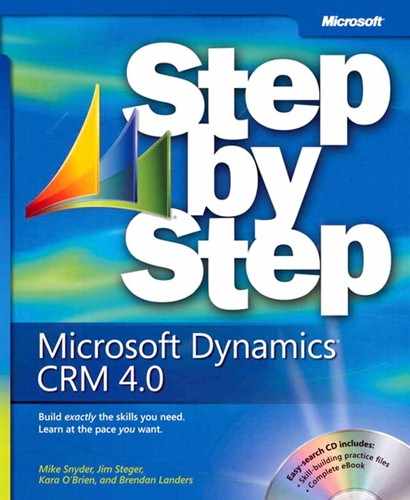When you are working with account and contact records in Microsoft Dynamics CRM, you might notice that two or more records appear very similar. For example, your system might contain more than one contact record for the same person in your system. Although you wouldn’t knowingly enter two records for the same person, it is possible that your system might contain duplicate records.
See Also
Microsoft Dynamics CRM includes many tools to help you avoid creating duplicate records in your system. For more information on configuring the duplicate check features, see Chapter 14.
Even though Microsoft Dynamics CRM includes powerful tools that help you to avoid duplicates, you will undoubtedly find a few duplicate records within your system. Fortunately, Microsoft Dynamics CRM includes a Merge tool that allows you to consolidate two different records into a single merged record. When merging two records, you specify one record as the master record, and Microsoft Dynamics CRM treats the other record as the child record. Microsoft Dynamics CRM deactivates the child record and copies all of the related records (such as activities, notes, and opportunities) to the master record. During the merge process, Microsoft Dynamics CRM presents you with a dialog box that allows you to populate data from individual fields in the child record so that you can preserve the data in the surviving master record. By merging duplicate records, you can maintain a clean customer database that will help with sales, marketing, and service productivity.
In this exercise, you will create a new contact record and merge it with an existing contact record. The same process is used to merge account and lead records.
Note
USE the Ben Burton contact record you created earlier in this chapter.
BE SURE TO use the Internet Explorer Web browser to navigate to your Microsoft Dynamics CRM Web site, if necessary, before beginning this exercise.
In the application menu tool bar, on the New Record menu, click Contact.
In the First Name field, enter Ben, and in the Last Name field, enter Burton. In the Fax field, enter (312) 555-0100. In the Parent Customer field, type Sonoma Partners.
The Parent Customer field should automatically resolve to the Sonoma Partners account record, as indicated by the underline and blue text color that the account name appears in.
In the contact toolbar, click Save and Close.
Click the Sales application area. In the navigation pane, click Contacts.
In the Quick Find text box, enter Burton, and then press
 .
.Microsoft Dynamics CRM lists the contact you just created and the Ben Burton contact record you created previously.
Holding the
 key down, click both Ben Burton records in the grid so that they are highlighted. In the grid toolbar, click the Merge button.
key down, click both Ben Burton records in the grid so that they are highlighted. In the grid toolbar, click the Merge button.The Merge Records dialog box opens. In this dialog box, you choose the master record by clicking the contact record you want to use. You can also select the data fields you want to keep from the child record in the surviving master record.
In the Fax field, click (312) 555-0100. When you do this, Microsoft Dynamics CRM keeps this fax data on the final record.
Click OK.
Microsoft Dynamics CRM merges the two records by updating the master record and deactivating the child record. When the process is complete, Microsoft Dynamics CRM displays an alert window telling you that the selected records have been merged and the subordinate record has been deactivated.
Click OK.
Microsoft Dynamics CRM closes the Merge Records dialog box.

